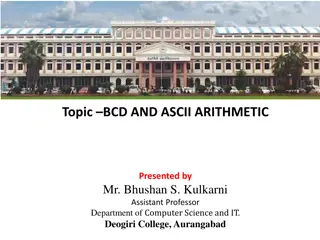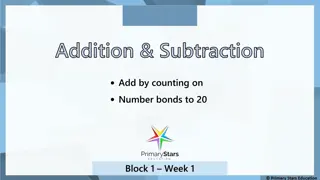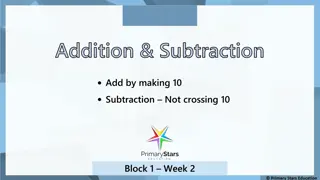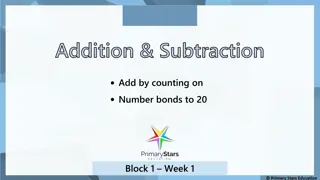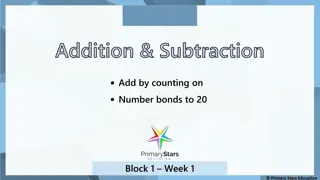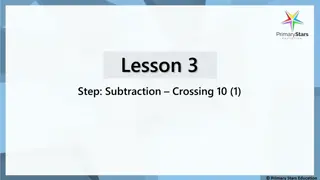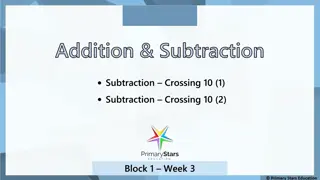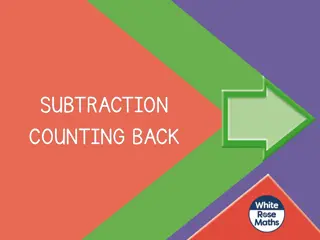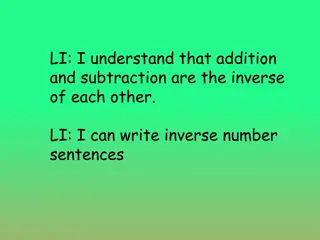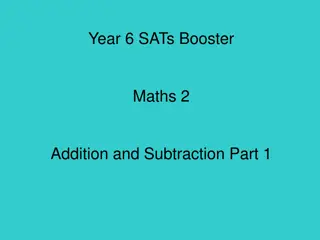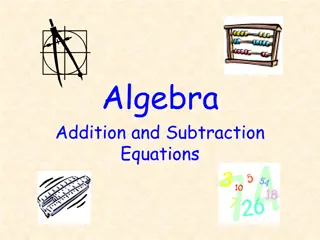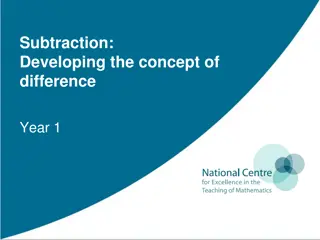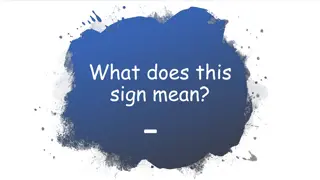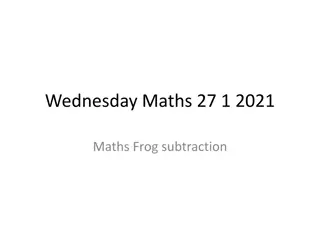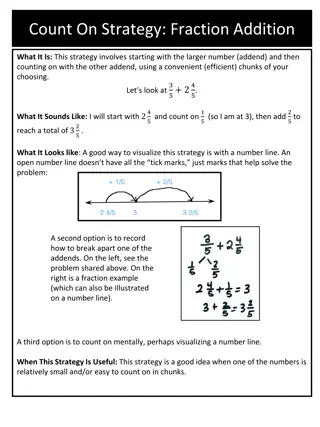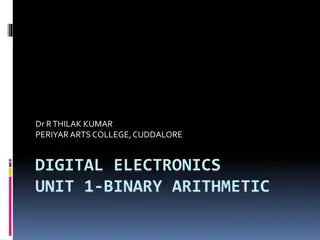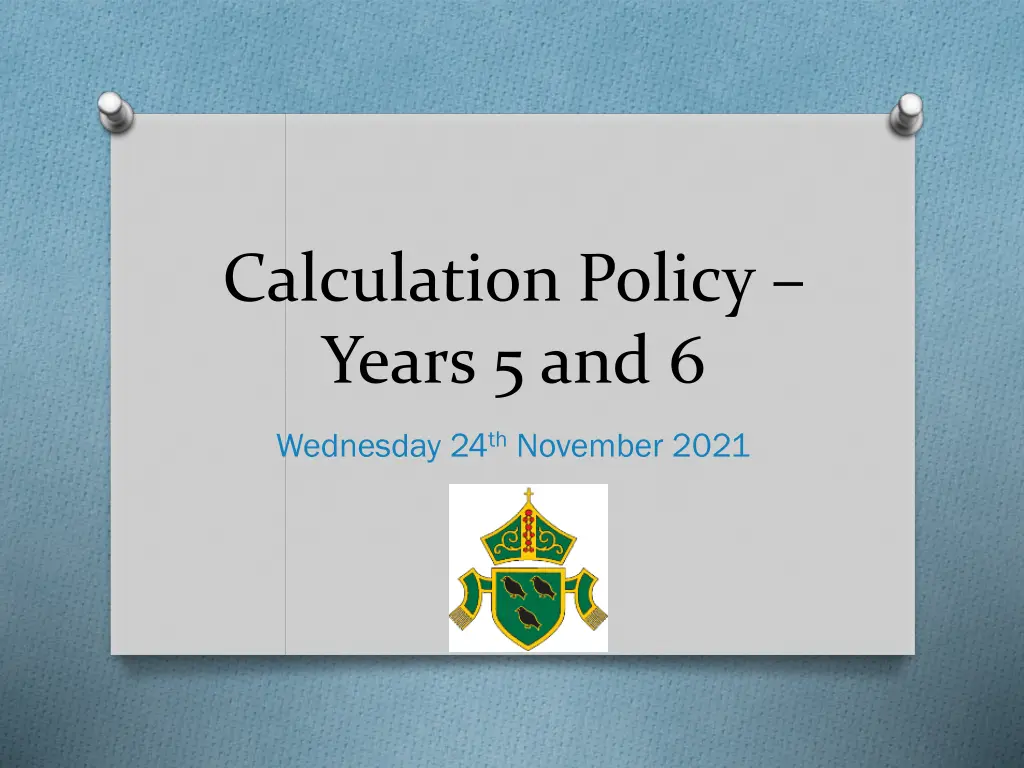
Maths Calculation Techniques for Years 5 and 6
Explore subtraction methods using number lines, expanded partitioning, and digit exchanges in Maths for Years 5 and 6 students. Practice with examples such as finding the nearest ten, jumping back in varied sizes, and column subtraction. Enhance your math skills with these practical techniques.
Download Presentation

Please find below an Image/Link to download the presentation.
The content on the website is provided AS IS for your information and personal use only. It may not be sold, licensed, or shared on other websites without obtaining consent from the author. If you encounter any issues during the download, it is possible that the publisher has removed the file from their server.
You are allowed to download the files provided on this website for personal or commercial use, subject to the condition that they are used lawfully. All files are the property of their respective owners.
The content on the website is provided AS IS for your information and personal use only. It may not be sold, licensed, or shared on other websites without obtaining consent from the author.
E N D
Presentation Transcript
Calculation Policy Years 5 and 6 Wednesday 24thNovember 2021
Stage 2 Number line 73 21 Start at 73. Jump back in tens twice (twenty). Then jump back one (one).
Stage 2 Consolidation of the number line method from Year 2, looking at using larger numbers. 124 48 Jump back to the nearest ten 124 4 = 120 Then subtract the remaining amount by jumping back in different sizes of jumps. The example above shows two jumps of twenty but you could use four jumps of ten or one jump of forty .
Stage 2 Number line (left to right finding the difference) 84 56 Start from 56 and jump to the nearest ten. Continue jumping until reaching 84. 4 + 10 + 10 + 4 4 + 10 + 10 + 4 = 28 This method should be used when finding a small difference between numbers (when the two numbers are close together e.g. 84 77).
Stage 2 Use of an empty number line (right to left) for HTO TO and HTO HTO 354 186
Over to you: Try using a number line to solve one of these calculations: 73 48 357 - 143
Stage 3 Expanded partitioning without exchanging 96 96 42 42 Step 1 write the calculation vertically 96 96 = = 90 + 6 90 + 6 - - 42 42 = = 40 + 2 54 50 + 4 Step 2 partitioning 40 + 2 Step 3 column subtraction
Stage 3 Expanded partitioning with exchanging 1) Write the calculation vertically 1) Write the calculation vertically 193 - 66
Stage 3 Expanded partitioning with exchanging 2) Partition the digits 2) Partition the digits 193 = 100 + 90 + 3 - 66 = 0 + 60 + 6
Stage 3 Expanded partitioning with exchanging 3) Subtract the ones column. As you cannot do 3 3) Subtract the ones column. As you cannot do 3 6 , you must exchange from the tens column, bringing one you must exchange from the tens column, bringing one ten into the ones column (thus taking one ten away ten into the ones column (thus taking one ten away from the tens column). 13 from the tens column). 13 6 = 7 80 80 193 = 100 + 90 + 13 - 66 = 0 + 60 + 6 7 6 , 6 = 7
Stage 3 Expanded partitioning with exchanging 4) Subtract the tens column (80 4) Subtract the tens column (80 60 = 20). 60 = 20). 80 193 = 100 + 90 + 13 - 66 = 0 + 60 + 6 20 + 7 80
Stage 3 Expanded partitioning with exchanging 5) Subtract the hundreds column (100 5) Subtract the hundreds column (100 0 = 100). 0 = 100). 80 193 = 100 + 90 + 13 - 66 = 0 + 60 + 6 100 + 20 + 7 80
Stage 3 Expanded partitioning with exchanging 6) Add the digits together (100 + 20 + 7 = 6) Add the digits together (100 + 20 + 7 = 127 127) ) 80 193 = 100 + 90 + 13 - 66 = 0 + 60 + 6 127 100 + 20 + 7 80
Over to you: Try using expanded partitioning with exchanging to solve one of these calculations: 363 147 548 175
Stage 3 into Stage 4 As for addition, once children are confident in using these methods, they can begin to use the more formal traditional method for subtraction.
Stage 4 81 193 - 66 127 As the one on the top line is smaller than the one on the bottom line, you must exchange from the tens column - the 3 becomes 13 and the 9 (tens) becomes 8 (tens).
Stage 4 This method continues through to Year 6, with more complex questions involving larger numbers and decimals.
Possible problems with vertical methods As for addition, the columns must be lined up accurately (ones on top of ones, tens on top of tens etc). Children may try to swap round the digit on the top with the one on the bottom. This will obviously completely change the question that they are trying to answer. Children may forget to exchange digits, or try to subtract from a digit that has been exchanged.
Espresso, Purple Mash and Times Table Rock Stars Please see the log-in information within your child s homework diary for access to these resources.
Key Stage 2 SATs Three mathematics papers Paper 1 Arithmetic (30 mins, 36 questions) Papers 2 and 3 Reasoning (40 mins, 20 questions approx.)

